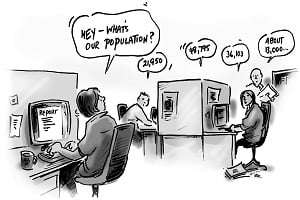When people ask – “How many people live in Statsville?” they expect a straight forward, unambiguous answer. If only it were that simple! Believe it or not there are several different ways to count people in places. Do you want to know how many were there on a particular day, or how many usually live there? In this blog we explain the different types of population statistics and when to use each one.

Enumerated population
Enumerated population refers to the population counted in a place on Census night. Because it’s impossible to catch everyone at home on one night, the Census counts people wherever they were sleeping that night. This might include people who usually live somewhere else but were staying in the area on business or holiday.
This type of count provides a snapshot at a given point in time. The Census is timed to capture the typical situation, however, holiday resort areas, such as the Gold Coast and snow fields, may show a large enumeration count compared with the number of people who usually live there. So that’s why we also have …
Usual Residence population
Usual Residence population refers to the population that usually lives in a place. It is an adaptation of the Census count. Each person completing the Census is required to state their address of usual residence and this information is used to derive the Usual Residence population.
Usual residence counts are less likely to be influenced by seasonal factors, such as holiday seasons and snow seasons, and provide information about the usual residents of an area. Since the 2006 Census, the results can be provided for both usual residence as well as enumerated population. However, some people don’t complete the Census form, or they may have been overseas on Census night. For this reason, both the enumerated and ususal residence populaton are known to underestimate the actual population. So that’s why we need…
Estimated Resident population (ERP)
The Estimated Resident Population (ERP) is the official ABS estimate of the Australian population. The ERP is based on results of the Census and is compiled as at 30 June of the Census year.
The ERP is based on the usual residence population and includes adjustments for Census undercount, Australian residents who were temporarily overseas on Census night, and backdates the population to 30 June.
It is updated between Censuses – quarterly for state and national figures, and annually for local government areas. The ERP provides a population figure between Censuses. Each year’s updates take into account births, deaths and both internal and overseas migration.
Estimated Resident Population is an estimate rather than an actual count, but is considered more accurate than a Census count because it includes people who were overseas on Census night, and adds in an estimate of any people missed by the Census.
Which population should I use?
As a general rule, if you just want an official population count you should use the Estimated Resident Population as it’s more accurate and is the official population figure. ERPs are also used as the basis for all future projections of the population.
However, the Estimated Resident Population is not broken down into population characteristics such as birthplace, industry or occupation etc. Therefore, iff you are exploring or reporting on the characteristics of a population you need to choose between the Enumerated or Usual Residence populations.
In the end, for most areas, it doesn’t matter much – the numbers will be very close, and if you’re looking at demographic characteristics, it’s normally percentages which matter, rather than raw numbers. Both populations are useful measures, and neither is “wrong”. You just need to make sure that you are consistent in which population group you decide to use, if you’re comparing information between different topics.
Areas with lots of hotels or full tourist accommodation even in winter include CBDs of major cities, Queensland coastal holiday resorts and NSW and Victorian skifields, and these areas are likely to show a difference between the two counts. In this case, if you want to know about how many people are both living and staying in the area and using servcies, you should use the enumerated population. But if you specifically want to know about the people who live in an area, use the usual resident population.
What about future populations?
To estimate the future demand for services and plan effectively, you will need to access population forecasts. All state governments publish population forecasts for each local government area in their state.
However, these forecasts have to reflect the current policies of the government, such as housing policy. While a government might have a policy to increase densification in the middle ring suburbs of a city, or to increase the percentage of the population living in regional centres, these things won’t necessarily happen (especially if the right infrastructure and incentives are not in place) and yet they will be reflected in the forecasts. An independent forecaster can take a more objective view.
You can access .id’s local government (and suburb) forecasts from our demographic resource centre.
If you would like to receive more updates about demographic or economic trends, do follow us on twitter @dotid or subscribe to our blog (above).










